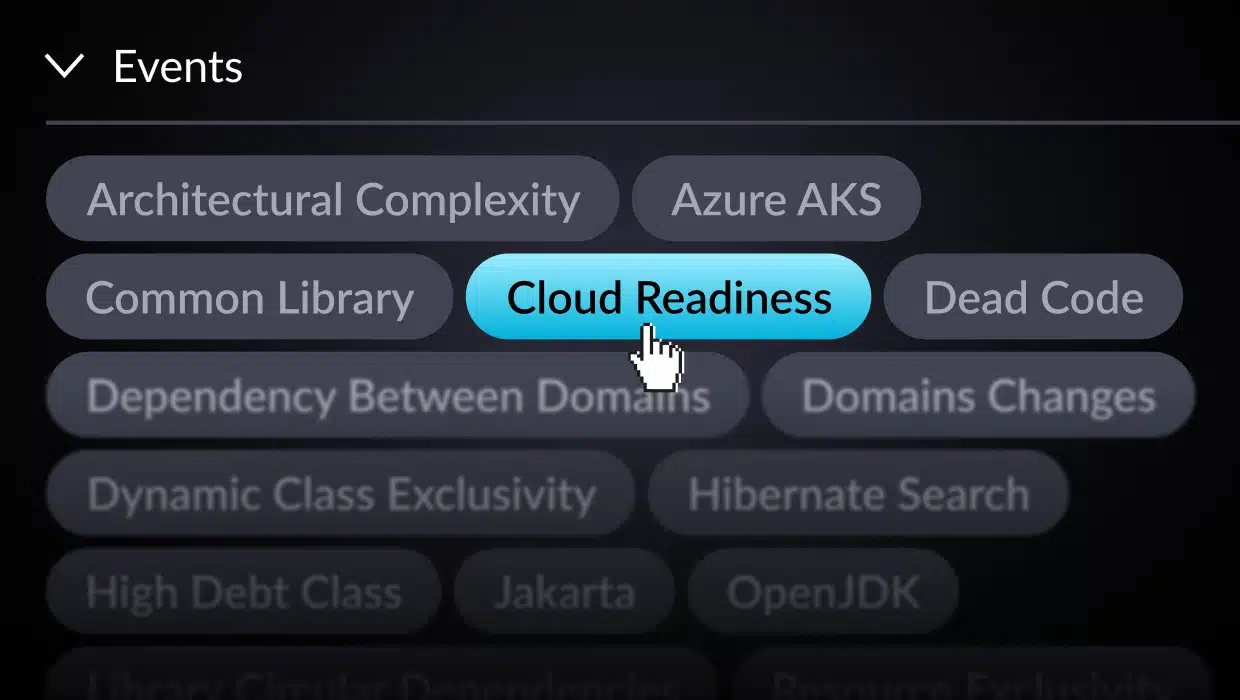Monolithic Java apps, often 20 years old or more, were never designed to run or leverage the cloud. As the technology scene takes shape, companies need to modernize and migrate their Java apps to make them suitable for the cloud.
Are you looking to make changes to your legacy apps and systems easier, faster, and more frequent? Moving them to a cloud-native architecture is the first step in the right direction. Cloud-native solutions are also more agile, cost-efficient, and easier to scale. However, you will need to conduct an application assessment for cloud migration before getting down to business.
While the benefits of cloud architectures are available for all to see, many organizations lack the tools or time needed to move their applications to the cloud. Organizations that fail to accurately assess and plan their application migrations to the cloud end up with a time-consuming and error-prone process.
Large enterprises (automotive, retail, insurance, and banking) have hundreds, sometimes thousands of these apps lying in data centers using old architectures. Moving these applications to the cloud lets you maintain or improve their business value and eliminate growing technical debt.
Why should you conduct an Application Assessment for Cloud Migration?
Before you start your cloud migration initiatives, you’ll need to assess your current application ecosystem. Application assessments are essential to help you determine the apps that you should move to the cloud and those that will remain in your legacy environment. Generally, some applications are more suitable for cloud architectures compared to others.
Using a data-driven and analytical approach, your organization can determine the relative difficulty in migrating an app to the cloud with a cost-benefit analysis. You can also assess the business value of making such a move. Besides, a rigorous assessment lays the groundwork for an automated and efficient transformation.
In addition to application modernization, cloud migrations assessments typically assess infrastructure and integration with other applications or data sources. Prepping this in advance will help sequence migrations so you know what happens if you migrate an application to the cloud and the other interconnected apps remain in-house. Your assessment team should come into the process with service level response time and performance requirements as part of the planning process.
Pre-migration planning is as critical as the implementation processes. This essential first step provides a solid footing before you proceed with your cloud migration plans. The idea behind these assessments is to ensure that you minimize the impact on your operations once you begin the migration process
How, then, should you conduct an application assessment for cloud migration?
Identify your Business Objectives
It is always necessary to understand why you want to implement a cloud migration initiative before starting the process. Failing to have clear objectives can derail your migration plans. Some of the typical business objectives for cloud migration include:
- Accelerating business agility
- Improving scalability
- Minimizing maintenance costs from in-house data centers
- Enhancing your failover capacity to boost app resilience
- Enhancing remote collaboration
Ensure that all your team members are on board with your cloud migration objectives. Once you are clear about why you need to move to the cloud, you’ll have an easier time deciding which applications you should migrate.
Besides, it would help if you had well-defined and realistic goals before making decisions concerning other migration processes. Your initial goals will help you select an appropriate cloud service provider and settle on the ideal migration strategy.
Identify Business Transactions
An essential discovery method consults with the business to find individual business transactions. Then, your team can document your app’s end-to-end flow within your IT infrastructure before mapping your business requirements. Remember to enter the value of different technological considerations that support your various applications.
While assessing your business transactions, you’ll need to identify end-users, transaction characteristics, and response time sensitivity. Ensure that you evaluate each transaction that has a unique flow through your IT systems. Migration complexity will depend on the different available interfaces, the functional requirements, and the integration standards. Understanding specific business transactions usually helps to reveal performance requirements.
Remember also to list and prioritize your applications, indicating both their business purpose and use case. Highlight applications that you may choose to retire and those that you’ve already deployed in the cloud.
Assess the Response Time Impact Risks
Your application assessment for cloud migration should also evaluate the impacts of migrating your apps. Assess the response characteristics of integration and sensitivity to delay. Assign all your transactions a rating that factors in sensitivity to delay and business importance.
If you rank any of your transactions as high importance and sensitive to delay, you’ll label them as high impact risk. With this information, you can test the response time impact, especially for more sensitive transactions. Assessing the response time impact ensures that your team can easily quantify the potential impact of changes while identifying potential migration opportunities.
Additionally, automated cloud migration solutions will help you prioritize your apps based on this data and information. Your team will quickly seamlessly assess the modernization complexity of your legacy apps and help you make a data-driven decision. From the assessment reports, you’ll easily determine the readiness and ease of modernization for your apps.
Ideally, you’ll need to establish a baseline of current transaction response times and then model the changes that occur once you switch the application and network conditions. Always prioritize real-time synchronous applications and those you consider response time-sensitive.Once you identify areas of concern, create an elaborate testing plan that focuses on assessing network flows of concern. While such pre-migration evaluations may involve lots of time and resources, you’ll make decisions based on credible information. Ultimately, you’ll understand how things work and make discoveries that can change pre-formed conclusions regarding your cloud migration initiatives.
Assess Infrastructure and Security Requirements
Your organization can predict its cloud environment needs once you are clear about the applications you want to move to the cloud. You might need to change specific applications to ensure that they suit your new architecture. Depending on your preference, you may adopt minor changes to an application’s core or completely rebuild the application. Alternatively, you might settle for software-as-a-service (SaaS) applications.
While at it, you may need to look at the security component of cloud applications. Government and industry regulations often take a prominent role when it comes to your cloud security posture. It is good practice to know where you have stored your data resources. This information helps you identify your security needs for different data sets.
Cloud experts suggest that organizations can exploit specific data securing approaches, including:
- Data encryption
- Monitoring and controlling access management
- Web application firewalls
- Setting up disaster recovery mechanisms
From your assessment, you can compare your requirements with your cloud service provider’s security offerings. If your organization runs in a specific sector like insurance or healthcare, you may need a niche provider who’ll support particular compliance requirements, like HIPAA. You may also want to identify potential vulnerabilities and make plans that address and mitigate those risks.
Evaluate Available In-house Resources
When considering available resources, you may want to answer a few questions, including:
- How much money are you willing to set aside?
- Is your IT team well-equipped for cloud migration?
- Does your team have enough availability to focus on your migration initiatives?
- Do you have any competing priorities at the moment?
Evaluate the skill-set of your in-house team with regard to cloud migration. It is essential to determine if your team has the required skills to guarantee a smooth cloud transition. Identify their weak points and educate them accordingly.
Empower your IT staff with relevant cloud migration skills to ensure that you apply best practices during this initiative. You can consider setting up a training program that educates your IT team. Alternatively, you can source for a strategic partner to help your team with the end-to-end execution of the migration process.
While assessing your resources, you may want to know if your IT team has any prior experience in cloud migration initiatives. Be sure also to evaluate whether you have the necessary migration tools and technologies.
Your in-house team understands your unique environment and specific needs. Empowering them adequately ensures that you implement a customized cloud environment. However, you could also opt to outsource your cloud migration services. A seasoned expert will fill the resource and knowledge gaps, albeit at an additional cost.
Classify Data
Determine sensitive data points, looking at the risk and corruption damage. Rank your data based on the risk factor, identifying those prone to deletion, intellectual property, and competitive theft.
Determine Migration Requirements and Compliance
Work with your tech department to determine all your top business and technical goals for cloud-based applications. Ensure that you are clear about any compliance requirements while figuring out how you’ll minimize licensing costs.
A rigorous assessment will deliver insights needed to make more informed strategic decisions regarding cloud migration. Evaluating your existing applications is often considerably time-consuming. The time you’ll spend on your assessments will depend on:
- Internal technical capabilities
- Quantity and complexity of legacy applications
- Available budgets
Assess your Operational Readiness
Although cloud operations deliver cutting-edge tools and technologies, you may face significant challenges once you implement these solutions. Therefore, it is essential to determine how you will manage the cloud’s operational aspects.
Brainstorm your preferred operational model for deployment. You can also discuss and agree with the various stakeholders regarding the different roles, responsibilities, and operating models. It may also be helpful to craft operational best practices as well as a robust plan that addresses business continuity or disaster recovery.
Proper assessments will put you in an excellent place to handle the post-migration cloud operations. This information also allows you to decide whether you’ll need to leverage a cloud-managed service provider to manage your cloud operation tasks for your organization.
Determine Your Timeline and Budget
Settling on an ideal timeline to complete the migration and determine the associated costs can be challenging for many organizations. Create reasonable timelines for specific milestones that you intend to hit during the cloud migration process. Timelines ensure that you track the progress you’ve made while outlining the reasons for any setbacks along the way. Be sure to consider your application migration methodology when setting your timelines.
Your budget, on the other hand, should align with your migration needs. Remember to include your ownership calculations, migration labor, migration training, and licensing costs. The total cost of ownership of the cloud typically determines your overall budget. To resolve this amount, you’ll need to factor in:
- The average resource unit size
- Monthly usage
- Estimated workload growth rate
- Security requirements
- Infrastructure overhead and management requirements.
Without adequate planning, your cloud networks may surpass the costs you incur when running your on-premise infrastructure. You also run the risk of exceeding your estimated timelines.
Do you need to outsource your Cloud Migration Assessments?
Your application assessment for cloud migration goes beyond simply knowing your operating systems and server platforms. Working with an experienced service provider offers access to discovery and analysis services that will better inform your decision-making processes. Besides, you’ll receive data-driven insights necessary to re-platform your applications for the cloud.
An ideal provider will help you analyze your apps and technologies. You’ll also receive insightful data that highlights your privacy requirements, operational costs, and business value. Outsourcing these assessments also helps you appreciate the health of your portfolio.
You’ll also have an easier time identifying the workloads and platforms that require early transitions. Ensure that your service provider works with your in house team to create a plan that prioritizes workloads that have the highest impact on your operations. Ideal service providers will also generate reports from your cloud assessment data.
Ace your Cloud Migration Application Assessments
An application assessment for cloud migration is essential for achieving a smooth migration process. With a comprehensive evaluation, you’ll have an easier time setting up a cloud environment that matches your organization needs and requirements. Formulating a clear plan for your cloud migration assessment helps you minimize the time and money you’ll spend while migrating.
Different cloud providers deliver tools and services needed to help you assess your applications for cloud migrations. vFunction’s cloud readiness assessments help you gain a clear understanding of your current IT infrastructure. We’ll also help you identify potential pitfalls that you can expect during your cloud migration.
Count on us to help you meticulously plan the steps that you’ll need to guarantee the success of your migration initiative. We’ll deploy robust solutions that help you eliminate the time, risk, and cost constraints associated with modernizing business applications. Do you want to learn more? Request a free demo today!







